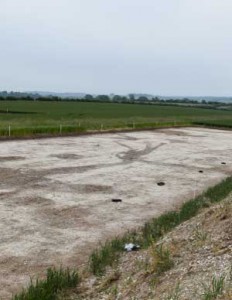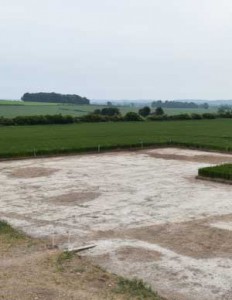Many questions are arising from Trench E, especially when trying to determine what time period it is. Many finds are being discovered from the trench, like a beautiful pot handle was discovered by one of our students.
From the aerial photograph images that were taken, we can see clearly a numerous amount of pits, gullies, ditches and possibly one or two roundhouses.

Photograph of Trench E from the top of the spoil heap (Copyright: Katie Moore, Bournemouth University)
The students in Trench E have started excavating only one side of the Trench to make sure that they cover all the features present. A timeline is slowly being created. But the main question to answer for week 2 is ‘what is the date of the roundhouse and how it is connected to the larger pits present’?
Trench D looks very different from Trench E. No roundhouses have been seen yet, however there is a large number of pits, gullies and ditches. It is believed that Trench D is more Roman than Iron-age but we will only know if this is true until more excavations have taken place. The main question for week 2 is determining whether the trench is more Iron-age or is it Late Bronze Age/Post Roman.
